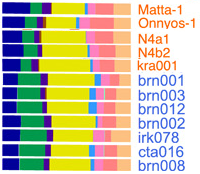”The burials of the “foundry workers” are an interesting and truly epoch-making phenomenon during the formation of metalworking production on the Eurasian continent. Almost simultaneously, graves with forging and foundry equipment appeared on a vast territory stretching from Western Europe to Siberia. Burials with stone forging tools were found in the burial grounds of the Bell Beaker culture near Städten in Saxony and at Lunteren and Soesterberg in the Netherlands [Matthias, 1964, S. 19–20; Bulter, Waals, 1967, p. 68–73]. Such graves are also known in Central Europe [Mozsolics, 1967, S. 28].
In Eastern Europe, burials of blacksmiths and foundry workers are found in the monuments of the Fatyanovo, Poltavka, Catacomb, and Abashevo cultures [Shilov, 1959, p. 13–19; 1966; Kakhovsky, 1963, p. 175–176; Krainov, 1971, p. 13; Derzhavin, Tikhonov, 1981; Ilyukov, 1986; Chernykh et al., 2005, p. 29–32]. They were also noted in the Trans-Urals [Korochkova, 2022, p. 64–67].
In Western Siberia, the earliest appearance of such burials was recorded in the Odinovo culture of the late 4th – early 3rd millennium BC. e. [Durakov, Mylnikova, 2021, p. 59–70]. The further development of this phenomenon in Siberia is associated primarily with the spread of the Seima-Turbino foundry tradition. Graves with forging and foundry equipment are available in the burial grounds Satyga-XVI, Saigatino VI [Korochkova, 2022, p. 67, fig. 7, 8], Rostovka [Matyushchenko, Sinitsyna, 1988, p. 30–34, 46–47], Tartas-1. In the necropolis Sopka-2/4B, V, 4 such graves were identified [Molodin, Grishin, 2016].
The appearance of “foundry workers’ burials,” as a rule, is considered an indisputable sign of the specialization of metalworking production and the identification of groups of professional craftsmen [Bochkarev, 1978. p. 48; Childe, 1947, b. 163]. They arise in the earliest period of the development of metalworking and indicate the organization of production within some traditional rather closed groups: patriarchal families, clans, lines[?].
It should be noted that industrial equipment marking graves is found in burials of all sex and age groups (men, women, adolescents and children), which indicates the involvement of all age and gender groups in metalworking activities, as well as the transfer of production skills from a certain society - new status. The high position of the deceased and the significant militarization of this social group is indicated by the presence of status items in the graves (stone maces, metal weapons, etc.). Apparently, trade and exchange transactions with metal, its processing and distribution led to a certain property stratification of society and the emergence of the rudiments of a political organization.”
Vyacheslav I. Molodin, Pavel V. Volkov & Igor A. Durakov. (2023).
Functional and technological analysis of artifacts from ”The Foundryman’s Burial” of the Sopka-2 burial ground.
https://cyberleninka.ru/article/n/funkt ... ka-sopka-2




